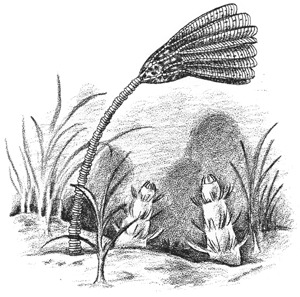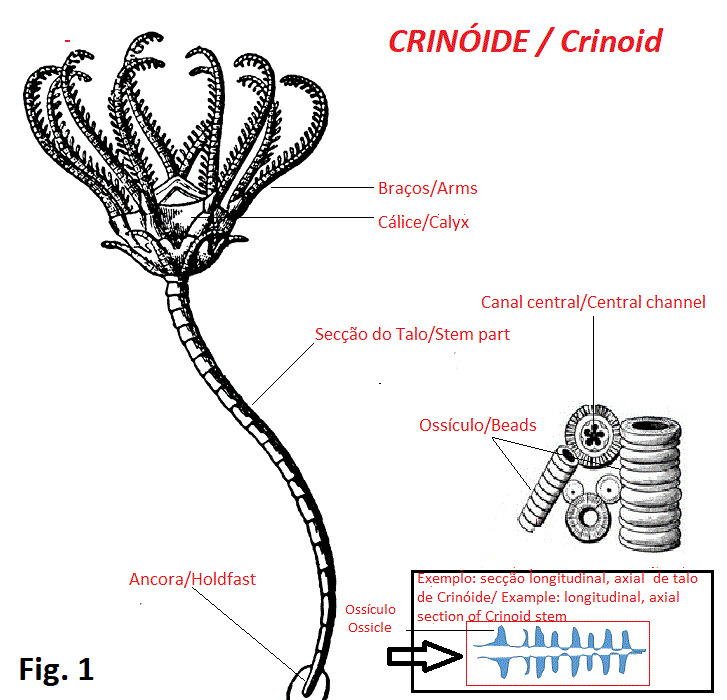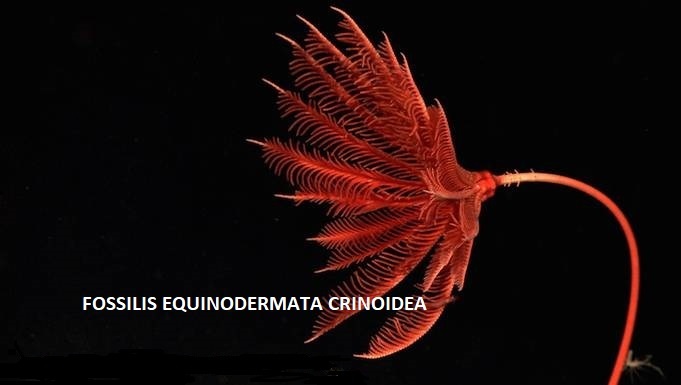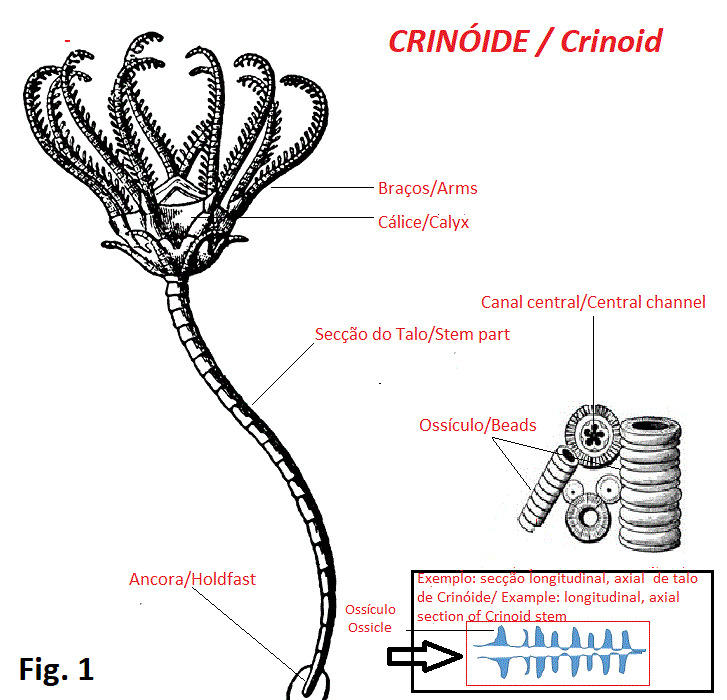
The Earth Cache:
The GZ is located in the perimeter of the Sciences school of the University of Lisbon with free access through its paths and alleys. In the given coordinates you will find a wall covered with ornamental limestone plates from the Estremenho Limestone Massif of the Portuguese West Mesocenozoic Orla, originating from the Moleanos Member attributed to the Callovian (Middle Jurassic) and that outcrop on the western flank of Serra dos Candeeiros, between Alto da Serra and parallel to Porto de Mós,

On the GZ, on the East side of the wall, search for the second limestone plate immediately after the last steps of the staircase. Among others, you should be able to identify a section of fossil of crinoid stem approximately 3 cms in length (aprox 1.2 inches).
To log in the Earth Cache I kindly ask you to verify Img. 1 in the listing to get a sense of what you will observing: it is a small segment of the stem of a crinoid, where it is possible to identify its structures, ossicles/beads.
After observing the site, I thank you for replying via email from my profile to the following questions
1 - The stalk of the fossil of Crinoid is displayed in an axial longitudinal section: taking this detail into account how many ossicles/beads can you count?
2 - Which comment best describes your observations in the GZ?
A) This Crinoid was an authentic Robinson Crusoe of the marine fossils!
B) Not quite! There was certainly a busy inter species rave party going on here!
C) Nonsense! It was, quite simply, an excellent marine water habitat for countless marine species!
D) Share your own though, if you prefer.
3 - Benthic sessile organisms inhabit the surface of the oceans and move according to the currents! true or false?
Sources:
https://www.portalsaofrancisco.com.br/biologia/filo-equinodermata
Silva, C.M. da (2014) - Geodiversidade no campus da FCUL. Fósseis de crinóides.

Fósseis, breve introdução:
A palavra "fóssil" deriva do termo latino "fossilis" que significa "ser desenterrado". A ciência que estuda os fósseis é a Paleontologia, sendo que fósseis são restos ou vestígios preservados de animais, plantas ou outros seres vivos em rochas, como moldes do corpo ou partes deste, rastros e pegadas.
A fossilização raramente ocorre porque a matéria orgânica dos seres vivos tende a ser rapidamente decomposta: com a morte do organismo a decomposição concorre para a sua destruição que tanto pode surgir por intervenção de microorganismos, ou por agentes físicos como alteração das condições de pressão e temperatura ou ainda por intervenção química por exemplo, oxidação, dissolução, etc...
Acontece que, por vezes, os restos orgânicos ficam rapidamente envolvidos num material protetor que os preserva do contacto com a atmosfera, da água do mar e dos agentes decompositores e desta forma acabam por se tornar fósseis, ou seja, quando os compostos orgânicos que constituem o organismo morto são substituídos por outros mais estáveis nas novas condições como por exemplo, calcite, sílica, pirite, carbono, entre outros.
Fósseis Crinóides:
Crinóides são organismos tipicamente marinhos que surgiram no Ordovício. Vivem abaixo da linha de maré e o seu habitat são as profundezas oceânicas até 6.000 mts de profundidade (atualmente não se encontram em ambientes de pequena profundidade, embora fossem comuns nestes ambientes no paleozoico e mesozoico).
Os Crinóides, também conhecidos como Lírios do pela sua semelhança com flores, pertencem ao grupo dos equinodermes (estrelas do mar, ouriços do mar, bolachas do mar, pepino do mar, são outros exemplos de Equinodermes). Os Crinóides possuem esqueleto interno formado por elementos carbonatadas constituídos por calcite que, no caso dos Lírios do Mar, se designam por Ossículos.
Nesta espécie os ossículos têm a particularidade de não estarem soldados uns aos outros, mantendo-se unidos apenas pelo corpo mole. Consequentemente, com a morte do animal estes ossículos separam-se e por esta razão é muito raro ocorrerem fósseis completos deste organismo. No entanto, os crinoides são considerados fósseis vivos, pois ainda existem e pouco mudaram desde a sua origem.
No seu topo, o corpo é um pequeno cálice constituído por placas calcárias ao qual estão presos, radialmente, braços ou tentáculos com pequenos apêndices que se estendem das laterais o que lhes confere um aspeto de penas. Os braços servem para capturar partículas em suspensão de que se alimentam por filtração.
São compostos por um corpo chato, pentagonal e flexível com o qual se fixam nos fundos marinhos (organismos bentónicos) com a particularidade de serem cumulativamente organismos sésseis, ou seja, organismos que vivem no fundo marinho, mas com locomoção reduzida ou inexistente preferindo ancorar-se fixos num local.

A Earth Cache:
O GZ situa-se no perímetro das instalações da FCUL com livre acesso através dos seus caminhos e alamedas. Nas coordenadas encontrarás um murete revestido a placas calcárias ornamentais provenientes do Maciço Calcário Estremenho da Orla Mesocenozóica Ocidental portuguesa, sendo originários do Membro Moleanos atribuído ao Calloviano (Jurássico Médio) e que aflora no flanco oeste da Serra dos Candeeiros, entre Alto da Serra e o paralelo de Porto de Mós,

No GZ, no murete no lado nascente e na segunda placa calcária ornamental imediatamente após os últimos degraus da escadaria, poderás identificar, entre outros, uma secção de fóssil de talo de crinóide com aproximadamente 3 cms de comprimento.
Para logares a Earth Cache agradeço que verifiques a Fig. 1 na listing para teres uma noção do que vais observar: trata-se de um pequeno segmento do talo de um crinoide, em que é possível identificar as suas estruturas, nomeadamente os ossículos constituintes.
Depois de observares o local agradeço que respondas via email do meu perfil às seguintes questões
1 – O talo do fóssil de Crinóide apresenta-se em corte longitudinal axial. Tomando em atenção esse pormenor, quantos ossículos consegues contar?
2 – Qual o comentário que selecionarias para descrever a placa de calcário do GZ?
A) Este crinoide era um autêntico Robison Crusoe dos fosseis marinhos!
B) Nada disso! Aqui decorria uma concorrida rave party inter espécies marinhas!
C) Que absurdo! Era, simplesmente um excelente habitat para inúmeras espécies marinhas.
D) Partilha o teu próprio comentário se assim entenderes.
3 – Organismos bentónicos sesseis habitam a superfície dos oceanos e deslocam-se ao sabor das correntes! verdadeiro ou falso?
Fontes:
https://www.portalsaofrancisco.com.br/biologia/filo-equinodermata
Silva, C.M. da (2014) - Geodiversidade no campus da FCUL. Fósseis de crinóides.